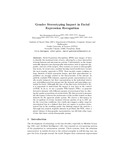Mostrar el registro sencillo del ítem
Gender stereotyping impact in facial expression recognition
| dc.creator | Domínguez Catena, Iris | es_ES |
| dc.creator | Paternain Dallo, Daniel | es_ES |
| dc.creator | Galar Idoate, Mikel | es_ES |
| dc.date.accessioned | 2023-09-07T07:23:07Z | |
| dc.date.available | 2024-01-31T00:00:15Z | |
| dc.date.issued | 2023 | |
| dc.identifier.citation | Dominguez-Catena, I., Paternain, D., & Galar, M. (2023). Gender stereotyping impact in facial expression recognition. En I. Koprinska, P. Mignone, R. Guidotti, S. Jaroszewicz, H. Fröning, F. Gullo, P. M. Ferreira, D. Roqueiro, G. Ceddia, S. Nowaczyk, J. Gama, R. Ribeiro, R. Gavaldà, E. Masciari, Z. Ras, E. Ritacco, F. Naretto, A. Theissler, P. Biecek, … S. Pashami (Eds.), Machine Learning and Principles and Practice of Knowledge Discovery in Databases (Vol. 1752, pp. 9-22). Springer Nature Switzerland. https://doi.org/10.1007/978-3-031-23618-1_1 | en |
| dc.identifier.isbn | 978-3-031-23617-4 | es_ES |
| dc.identifier.uri | https://hdl.handle.net/2454/46244 | |
| dc.description.abstract | Facial Expression Recognition (FER) uses images of faces to identify the emotional state of users, allowing for a closer interaction between humans and autonomous systems. Unfortunately, as the images naturally integrate some demographic information, such as apparent age, gender, and race of the subject, these systems are prone to demographic bias issues. In recent years, machine learning-based models have become the most popular approach to FER. These models require training on large datasets of facial expression images, and their generalization capabilities are strongly related to the characteristics of the dataset. In publicly available FER datasets, apparent gender representation is usually mostly balanced, but their representation in the individual label is not, embedding social stereotypes into the datasets and generating a potential for harm. Although this type of bias has been overlooked so far, it is important to understand the impact it may have in the context of FER. To do so, we use a popular FER dataset, FER+, to generate derivative datasets with different amounts of stereotypical bias by altering the gender proportions of certain labels. We then proceed to measure the discrepancy between the performance of the models trained on these datasets for the apparent gender groups. We observe a discrepancy in the recognition of certain emotions between genders of up to 29 % under the worst bias conditions. Our results also suggest a safety range for stereotypical bias in a dataset that does not appear to produce stereotypical bias in the resulting model. Our findings support the need for a thorough bias analysis of public datasets in problems like FER, where a global balance of demographic representation can still hide other types of bias that harm certain demographic groups. | en |
| dc.description.sponsorship | This work was funded by a predoctoral fellowship of the Research Service of Universidad Publica de Navarra, the Spanish MICIN (PID2019-108392GB-I00 and PID2020-118014RB-I00 / AEI / 10.13039/501100011033), and the Government of Navarre (0011-1411-2020-000079 - Emotional Films). | en |
| dc.format.mimetype | application/pdf | en |
| dc.language.iso | eng | en |
| dc.publisher | Springer | en |
| dc.relation.ispartof | Koprinska, I.; Mignone, P.; Guidotti, R.; Jaroszewicz, S.; Fröning, H.; Gullo, F.; Ferreira, P. M.; Roqueiro, D.; Ceddia, G.; Nowaczyk, S.; Gama, J.; Ribeiro, R.; Gavaldà, R.; Masciari, E.; Ras, Z.; Ritacco, E.; Naretto, F.; Theissler, A.; Biecek, P.; Pashami, S. (Eds.). ECML PKDD 2022: Machine Learning and Principles and Practice of Knowledge Discovery in Databases. Cham: Springer; 2023. p.9-22 978-3-031-23617-4 | en |
| dc.rights | © 2023 The Author(s), under exclusive license to Springer Nature Switzerland AG. | en |
| dc.subject | Facial expression recognition | en |
| dc.subject | Gender stereotyping | en |
| dc.subject | Stereotypical bias | en |
| dc.title | Gender stereotyping impact in facial expression recognition | en |
| dc.type | Contribución a congreso / Biltzarrerako ekarpena | es |
| dc.type | info:eu-repo/semantics/conferenceObject | en |
| dc.date.updated | 2023-09-07T07:09:18Z | |
| dc.contributor.department | Estadística, Informática y Matemáticas | es_ES |
| dc.contributor.department | Estatistika, Informatika eta Matematika | eu |
| dc.contributor.department | Institute of Smart Cities - ISC | en |
| dc.rights.accessRights | Acceso abierto / Sarbide irekia | es |
| dc.rights.accessRights | info:eu-repo/semantics/openAccess | en |
| dc.embargo.terms | 2024-01-31 | |
| dc.identifier.doi | 10.1007/978-3-031-23618-1_1 | |
| dc.relation.projectID | info:eu-repo/grantAgreement/AEI/Plan Estatal de Investigación Científica y Técnica y de Innovación 2017-2020/PID2020-118014RB-I00/ES/ | en |
| dc.relation.projectID | info:eu-repo/grantAgreement/Gobierno de Navarra//0011-1411-2020-000079 | en |
| dc.relation.publisherversion | https://doi.org/10.1007/978-3-031-23618-1_1 | |
| dc.type.version | Versión aceptada / Onetsi den bertsioa | es |
| dc.type.version | info:eu-repo/semantics/acceptedVersion | en |
| dc.contributor.funder | Universidad Pública de Navarra / Nafarroako Unibertsitate Publikoa | es |


